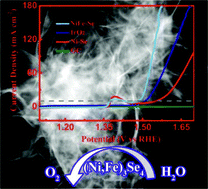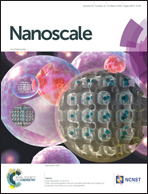Hierarchical Fe-doped Ni3Se4 ultrathin nanosheets as an efficient electrocatalyst for oxygen evolution reaction†
Abstract
Developing highly efficient oxygen evolution reaction (OER) electrocatalysts is critical to the cost-effective generation of clean fuels. Transition-metal selenides have been proposed to be OER catalyst alternatives to noble metal based catalysts, but generally exhibit limited electrocatalytic activity. We here report hierarchical Fe-doped Ni3Se4 ((Ni,Fe)3Se4) ultrathin nanosheets as an efficient electrocatalyst for OER in alkaline electrolytes. The preparation involves a solvothermal synthesis and a topotactic conversion process. The prepared hierarchical (Ni,Fe)3Se4 ultrathin nanosheets show abundant and accessible catalytically active sites, facile charge transfer and a high specific surface area. Relative to the Ni3Se4 nanosheets, the as-prepared (Ni,Fe)3Se4 ultrathin nanosheets show a higher current density and a lower Tafel slope towards the OER. Remarkably, hierarchical (Ni,Fe)3Se4 ultrathin nanosheets supported on Ni foam exhibit an electrocatalytic OER with a current density of 10 mA cm−2 at a low overpotential of 225 mV and a small Tafel slope of about 41 mV dec−1. This study establishes (Ni,Fe)3Se4 ultrathin nanosheets as an efficient electrocatalyst for the OER that can be used in the fields of metal–air batteries and water splitting for hydrogen production.



 Please wait while we load your content...
Please wait while we load your content...